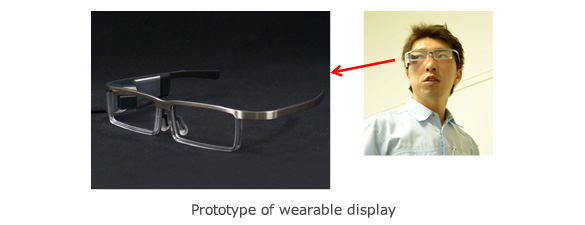Corporate Research & Development Center
Development of a video display technology for wearable displays
Overview
Toshiba has developed a video display technology for an easy-to-see and easy-to-wear display which displays videos in wearer's vision.
Development background
There has been a growing demand for complex maintenance and inspection routines over the past few years, as infrastructure becoming obsolete or devices becoming more sophisticated. However, because number of qualified mechanics who can perform complex maintenance and inspection tasks could not cope with the demand, ICT technology is anticipated to enhance work efficiency and remedy such problem. In response to such demand, Toshiba has developed a proprietary video display technology for displaying operating procedure and diagrams on the wearer's vision that frees wearer's both hands(for more meaningful tasks). Furthermore, our wearable display may be used in combination with devices such as tablets.
Conventional technology and issues
Conventional devices often place the display unit outside of the frame. However, such display often disrupts the wearer's vision, resulting in user having to adapt to the angle so as to see displayed contents clearly. Also, most conventional devices are too heavy for prolonged usage.
Features of the technology
With our new video display technology, the display is placed inside the frame and reflects the image onto the lens, allowing viewing of images within the wearer's vision.. As such, being less intrusive to the wearer's vision allows the wearer to perform tasks smoothly. Furthermore, making the display unit smaller allows the wearer to use the device comfortably, just like wearing a pair of glasses which reduces fatigue in prolonged usage. Since the device displays images in wearer's vision, there is no need for shifting of focus. We are also developing a device that allows the user to work intuitively by overlapping an image on a real object.

Outlook
We will continue work on making the display smaller and lighter, improving image quality and to provide a wider viewing angle to improve efficiency in maintenance, inspection or any other tasks associated with social infrastructure.


